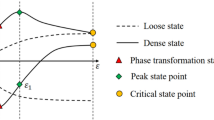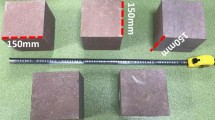Abstract
This paper describes a liquid application device used in combination with a split Hopkinson pressure bar (SHPB) to perform a series of dynamic tests investigating stress wave propagation through a fully saturated rock joint under undrained conditions. The characteristics of the filling-liquid dynamic response are also analyzed. Granite is used as the experimental material for the rock joint and a dynamic load is applied by the SHPB device to simulate the interaction between a stress wave and the liquid-filled rock joint. In addition, a polymethyl methacrylate (PMMA) sample of the same size as the granite is used for comparative analysis. The initial thickness of the filling liquid is altered by adjusting the sample joint spacing. The transmission coefficient of a stress wave in the liquid-filled rock joint is defined to evaluate the wave attenuation and to analyze the characteristics of the filling liquid’s dynamic response. The experimental results obtained for granite and PMMA demonstrate that the transmission coefficient decreases with increasing liquid filling thickness. As the initial thickness of the filling liquid increases, the peak liquid pressure increases. There is a negative correlation between the peak water pressure value and the transmission coefficient.





















Similar content being viewed by others
Abbreviations
- \(\varepsilon_{{ 1 {\text{st,In}}}} ,\;\varepsilon_{{ 1 {\text{st,Tr}}}}\) :
-
First incident wave peak strain, first transmitted wave peak strain
- PWP :
-
Peak pressure of filling liquid
- t :
-
Initial thickness of filling liquid
- TR :
-
Transmission coefficient
- K :
-
Transmission-wave peak strain value amplification factor
- \({\Delta}TR_{ 1} ,\;{\Delta}TR_{ 2} ,\;{\Delta}TR_{ 3}\) :
-
Degree of variation in transmission coefficient influenced by the metal-material, material-water-material, and material-metal contact surfaces, respectively
- \(TR_{\text{Original}}\) :
-
Transmission coefficient directly obtained from the test
- \({\Delta}TR_{{{\text{Metal}} - {\text{Material}}}}\) :
-
Degree of variation in transmission coefficient influenced by the uniform contact surface between the metal bars and sample
- \({\Delta}TR_{{{\text{Filling}}\,{\text{liquid}}}}\) :
-
Degree of variation in transmission coefficient influenced by the presence of liquid filling layer
- \(TR_{\text{Corrected}}\) :
-
Transmission coefficient after correcting the influence of the contact surface between the metal bars and sample
References
Bandis SC, Lumsden AC, Barton NR (1983) Fundamentals of rock joint deformation. Int J Rock Mech Min Sci Geomech Abs 20:249–268. https://doi.org/10.1016/0148-9062(83)90595-8
Brekhovskikh LM (1962) Waves in layered media. Phys Today 15(4):70–74
Cai JG, Zhao J (2000) Effects of multiple parallel fractures on apparent attenuation of stress waves in rock masses. Int J Rock Mech Min Sci 37:661–682. https://doi.org/10.1016/S1365-1609(00)00013-7
Christensen RJ, Swanson SR, Brown WS (1972) Split-Hopkinson-bar tests on rock under confining pressure. Exp Mech 12:508–513. https://doi.org/10.1007/BF02320747
Dai F, Huang S, Xia KW, Tan ZY (2010) Some fundamental issues in dynamic compression and tension tests of rocks using split Hopkinson pressure bar. Rock Mech Rock Eng 43:657–666. https://doi.org/10.1007/s00603-010-0091-8
Du QH, Liu XL, Wang EZ, Wang SJ (2017) Strength reduction of coal pillar after co2 sequestration in abandoned coal mines. Minerals 7(2):26. https://doi.org/10.3390/min7020026
Fan LF, Yi XW, Ma GW (2013) Numerical manifold method (NMM) simulation of stress wave propagation through fractured rock mass. Int J Appl Mech 5(2):1350022. https://doi.org/10.1142/S1758825113500221
Fehler M (1982) Interaction of seismic waves with a viscous liquid layer. Bull Seism Soc Am 72(1):55–72
Hopkinson J (1872) On the rupture of iron wire by a blow. Proc Lit Philos Soc Manch 11:40–45
Hopkinson B (1914) A method of measuring the pressure produced in the detonation of high explosives or by the impact of bullets. Philos Trans R Soc A 213:437–456. https://doi.org/10.1098/rsta.1914.0010
Hrennikoff A (1941) Solution of problems of elasticity by the framework method. ASME J Appl Mech 8:A619–A715
Huang XL, Qi SW, Xia KW, Zheng H, Zheng BW (2016) Propagation of high amplitude stress waves through a filled artificial joint: an experimental study. J Appl Geophys 130:1–7. https://doi.org/10.1016/j.jappgeo.2016.04.003
Hudson JA, Liu E, Crampin S (1996) Transmission properties of a plane fault. Geophys J R Astron Soc 125(2):559–566. https://doi.org/10.1111/j.1365-246X.1996.tb00018.x
Jones JP, Whittier JS (1967) Waves at a flexibly bonded interface. J Appl Mech 34(4):905–909. https://doi.org/10.1115/1.3607854
King MS, Myer LR, Rezowalli JJ (1986) Experimental studies of elastic-wave propagation in a columnar-jointed rock mass. Geophys Prospect 34:1185–1199. https://doi.org/10.1111/j.1365-2478.1986.tb00522.x
Kolsky H (1949) An investigation of the mechanical properties of materials at very high rates of loading. Proc Phys Soc B 62:676–700. https://doi.org/10.1088/0370-1301/62/11/302
Li JC, Ma GW (2009) Experimental study of stress wave propagation across a filled rock joint. Int J Rock Mech Min Sci 46:471–478. https://doi.org/10.1016/j.ijrmms.2008.11.006
Li JC, Ma GW, Huang X (2010) Analysis of wave propagation through a filled rock joint. Rock Mech Rock Eng 43:789–798. https://doi.org/10.1007/s00603-009-0033-5
Li XF, Li HB, Li JC, Li ZW (2018) Research on transient wave propagation across nonlinear joints filled with granular materials. Rock Mech Rock Eng 51:2373–2393. https://doi.org/10.1007/s00603-018-1471-8
Lindholm US, Yeakley LM (1968) High strain-rate testing: tension and compression. Exp Mech 8:1–9. https://doi.org/10.1007/BF02326244
Liu XL, Wang SY (2012) Mine water inrush forecasting during the mining under waters. Disaster Advances 5(4):877–882
Liu E, Crampin S, Hudson JA, Rizer WD, Queen JH (1995) Seismic properties of a general fracture. In: Rossmanith HP (ed) Mechanics of JOINTED AND FAULTED ROCK. Balkma, Rotterdam
Liu XL, Wang SY, Wang SJ, Wang EZ (2015) Fluid-driven fractures in granular materials. Bull Eng Geol Env 74(2):621–636. https://doi.org/10.1007/s10064-014-0712-7
Liu XL, Han GF, Wang EZ, Wang SJ, Nawnit K (2018) Multiscale hierarchical analysis of rock mass and its mechanical and hydraulic properties prediction. J Rock Mech Rock Eng 10(4):694–702. https://doi.org/10.1016/j.jrmge.2018.04.003
Ma GW, Li JC, Zhao J (2011) Three-phase medium model for filled rock joint and interaction with stress waves. Int J Numer Anal Meth Geomech 35:97–110. https://doi.org/10.1002/nag.941
Miller RK (1977) An approximate method of analysis of the transmission of elastic waves through a frictional boundary. J Appl Mech 44:652–656. https://doi.org/10.1115/1.3424152
Pyrak-Nolte LJ (1988) Seismic visibility of fracture. Dissertation, University of California, Berkeley
Pyrak-Nolte LJ, Myer LR, Cook NGW (1990) Transmission of seismic waves across single natural fractures. J Geophys Res 95:8617–8638. https://doi.org/10.1029/JB095iB06p08617
Rokhlin SI, Marom D (1986) Study of adhesive bonds using low-frequency obliquely incident ultrasonic waves. J Acoust Soc Am 80(2):585–590. https://doi.org/10.1121/1.394053
Rokhlin SI, Wang YJ (1991) Analysis of boundary conditions for elastic wave interaction with an interface between two solids. J Acoust Soc Am 89(2):503–515. https://doi.org/10.1121/1.400374
Ross CA, Thompson PY, Tedesco JW (1989) Spilt-Hopkinson pressure-bar tests on concrete and mortar in tension and compression. ACI Mater J 86(5):475–481. https://doi.org/10.14359/2065
Schoenberg M (1980) Elastic wave behavior across linear slip interfaces. J Acoust Soc Am 68(5):1516–1521. https://doi.org/10.1121/1.385077
Sebastian R, Sitharam TG (2015) Long wavelength propagation of elastic waves across frictional and filled rock joints with different orientations: experimental results. Geotech Geol Eng 33:923–934. https://doi.org/10.1007/s10706-015-9874-8
Shi GH (1991) Manifold method of material analysis. In: Proceedings of the Transactions of the 9th Army Conference on applied mathematics and computing. Minneapolis: Minnesota, pp. 57–76
Shi GH (1992) Modeling rock joints and blocks by manifold method. In: Proceedings of the 33rd US Rock Mechanics Symposium, Santa Fe, New Mexico, pp 639–648
Sun H, Liu XL, Zhu JB (2019) Correlation fractal characterization of stress and acoustic emission during coal and rock failure under multilevel dynamic loadings. Int J Rock Mech Min Sci 117:1–10. https://doi.org/10.1016/j.ijrmms.2019.03.002
Wei XF, Liu XL, Duan YL, Feng JM (2017) Property transformation of a modified sulfoaluminate grouting material under pressure circulation for a water-sealed underground oil cavern. Constr Build Mater 140:210–220. https://doi.org/10.1016/j.conbuildmat.2017.02.137
Wu YK, Hao H, Zhou YX, Chong K (1998) Propagation characteristics of blast-induced shock waves in a jointed rock mass. Soil Dyn Earthq Eng 17(6):407–412. https://doi.org/10.1016/S0267-7261(98)00030-X
Wu W, Zhu JB, Zhao J (2013a) Dynamic response of a rock fracture filled with viscoelastic materials. Eng Geol 160:1–7. https://doi.org/10.1016/j.enggeo.2013.03.022
Wu W, Zhu JB, Zhao J (2013b) A further study on seismic response of a set of parallel rock fractures filled with viscoelastic materials. Geophys J Int 192:671–675. https://doi.org/10.1093/gji/ggs055
Wu W, Li JC, Zhao J (2013c) Seismic response of adjacent filled parallel rock fractures with dissimilar properties. J Appl Geophys 96:33–37. https://doi.org/10.1016/j.jappgeo.2013.06.009
Xia KW, Yao W (2015) Dynamic rock tests using split Hopkinson (Kolsky) bar system: a review. J Rock Mech Geotech Eng 7:27–59. https://doi.org/10.1016/j.jrmge.2014.07.008
Yu Y, Wang EZ, Zhong JW, Liu XL, Li PH, Shi M, Zhang ZG (2014) Stability analysis of abutment slopes based on long-term monitoring and numerical simulation. Eng Geol 183:159–169. https://doi.org/10.1016/j.enggeo.2014.10.010
Zhang QB, Zhao J (2014) A review of dynamic experimental techniques and mechanical behaviour of rock materials. Rock Mech Rock Eng 47:1411–1478. https://doi.org/10.1007/s00603-013-0463-y
Zhao GF, Fang J, Zhao J (2011) A 3D distinct lattice spring model for elasticity and dynamic failure. Int J Numer Anal Met 35(8):859–885. https://doi.org/10.1002/nag.930
Zhu JB, Perino A, Zhao GF, Barla G, Li JC, Ma GW, Zhao J (2011a) Seismic response of a single and a set of filled joints of viscoelastic deformational behaviour. Geophys J Int 186:1315–1330. https://doi.org/10.1111/j.1365-246X.2011.05110.x
Zhu JB, Zhao GF, Zhao XB, Zhao J (2011b) Validation study of the distinct lattice spring model (DLSM) on p-wave propagation across multiple parallel joints. Comput Geotech 38(2):298–304. https://doi.org/10.1016/j.compgeo.2010.12.002
Zhu JB, Zhao XB, Wu W, Zhao J (2012) Wave propagation across rock joints filled with viscoelastic medium using modified recursive method. J Appl Geophys 86(11):82–87. https://doi.org/10.1016/j.jappgeo.2012.07.012
Acknowledgements
The National Key Research and Development Plan (Grant No. 2018YFC1504801), the National Natural Science Foundation Outstanding Youth Foundation (Grant No. 51522903) and the National Natural Science Foundation of China (Grant No. 51479094, 41772246) are gratefully acknowledged.
Author information
Authors and Affiliations
Corresponding author
Additional information
Publisher's Note
Springer Nature remains neutral with regard to jurisdictional claims in published maps and institutional affiliations.
Rights and permissions
About this article
Cite this article
Huang, J., Liu, X., Zhao, J. et al. Propagation of Stress Waves Through Fully Saturated Rock Joint Under Undrained Conditions and Dynamic Response Characteristics of Filling Liquid. Rock Mech Rock Eng 53, 3637–3655 (2020). https://doi.org/10.1007/s00603-020-02126-y
Received:
Accepted:
Published:
Issue Date:
DOI: https://doi.org/10.1007/s00603-020-02126-y




